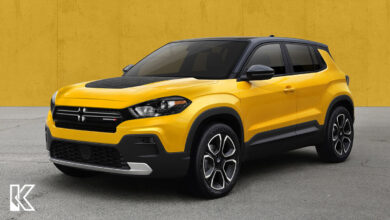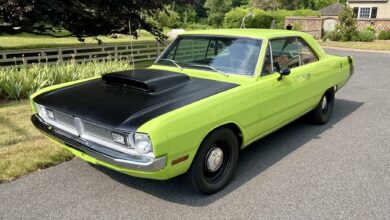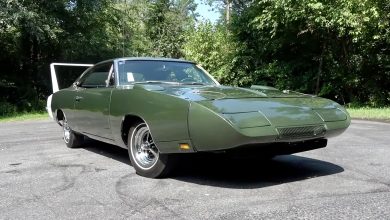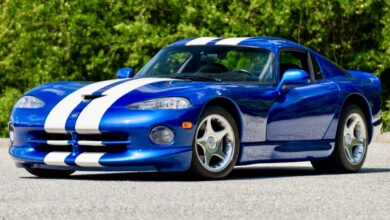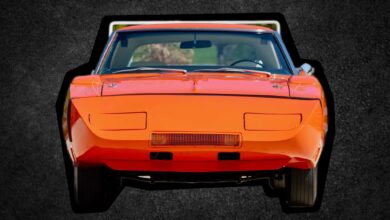
This month marks four years since the debut of the ultimate street-legal track-focused supercar from Dodge//SRT, the 2016 Dodge Viper ACR (American Club Racer). While the Viper may be gone, it is surely not forgotten. We figured we would take a look back at what made the American supercar GEN V (5th Generation) Dodge Viper ACR so great.

The SRT engineering team that developed the Dodge Viper ACR was well-stocked with members who race their own cars, as well as learning from the factory-based racing Viper GTS-R that competed in the American Le Mans Series and IMSA United SportsCar Championship from 2012-2014, capturing the GTLM class driver and team championships in 2014. For the Viper ACR, the team focused its efforts on three areas: aerodynamics, chassis, and tires to maximize grip, producing never-seen-before handling capabilities and unprecedented lap times.
The 2016 Dodge Viper ACR featured a standard front splitter, lower dive planes and a 1,776 mm-wide adjustable, dual element rear wing, which is 54% larger (in top surface area) than the TA (Time Attack) 2.0 and which helped to provide 1,101 pounds of downforce at 150 miles per hour (mph) and 1,533 pounds of downforce at 177 mph top speed.

The Viper ACR’s available Extreme Aero Package produced the highest aerodynamic downforce of any production car. During on-track testing, SRT development engineers experienced unprecedented downforce numbers of 1,200+ pounds at 150 mph and 1,700+ pounds at 177 mph top speed, and 12% more downforce over the base ACR on straightaways and 21% more downforce during aggressive cornering.

The Extreme Aero Package included a huge (1,876-mm wide) adjustable dual-element rear wing, which is 62% larger (in top surface area) than Viper TA 2.0, rear carbon fiber diffuser, unique SRT hood with removable louvers, detachable extension for the front splitter and four dive planes. The Extreme Aero rear wing, specifically designed for airflow around the Viper’s body, stood taller, sat further rearward and featured unique end-plates and gurney lip to produce maximum downforce while minimizing straight line drag. The Extreme Aero Package delivered more than three times the downforce of the Viper TA 2.0 Package.
The rear carbon fiber diffuser extended forward of the rear axle. It included six removable strake extensions, designed to rub against the track surface for increased straight-line stability and optimized downforce. Removable hood louvers over the front tires reduced air pressure in front wheel wells to provide additional downforce. The detachable front splitter extension and dive planes worked with the rear aerodynamic treatment to provide outstanding grip and balanced performance on the track.

The Dodge Viper ACR featured new Brembo® Carbon Ceramic Matrix brakes for optimum braking performance with unprecedented brake fade resistance, and greater handling capability through reduced unsprung weight. The system used 390-millimeter (15.4-inch) two-piece front rotors and 360-millimeter (14.2-inch) two-piece rear rotors. Front brakes used six-piston Brembo® calipers while the rear brakes used four-piston calipers.

The Carbon Ceramic Matrix brakes had the largest brake pad area ever on Viper. The brakes worked in conjunction with ABS and ESC specifically tuned for the ACR to take into account the extra grip provided by the additional aero and specifically designed Kumho® tires. Detachable front brake ducts provided additional cooling to the brake calipers for optimum track performance.

Viper ACR was fitted with Kumho® Ecsta V720 high-performance tires designed specifically for the car with a unique tread pattern and compounds for front and rear. In testing, the tires produce laps times that were 1.5-seconds faster than off-road only race tires.

Low-profile front tires measured 295/25/19 and were mounted on wider 11-inch wide wheels and when combined with the 355/30/19 rear tires, they provided the largest combined tire patch available on any production car. On the sidewall of the tires is a unique raised ACR logo.
Viper ACR’s ABS and five-mode Electronic Stability Control system (Full-on, Sport, Track, Rain, Full-off modes) were specifically tuned for the car to take into account the extra grip offered by the extreme aerodynamic and tire package.

Aluminum bodied, double-adjustable coil-over Bilstein race shocks were designed specifically for the Viper ACR and worked in conjunction with ride height adjustment for optimal control of weight transfer and handling performance. Each shock provided independent 10-way rebound and compression adjustability. The suspension package also provided more than 3-inches of ride height adjustment.

Front springs were rated at 600 lbs./in. and rear springs at 1,300 lbs./in., more than double the suspension stiffness of the Viper TA model. With unique race alignment and 1.4 degrees more negative camber than the entry SRT model, the Viper ACR was capable of sustaining more than 1.5 g on high-speed turns due to the combined chassis and aerodynamic improvements.

At the heart of the Viper ACR was the handcrafted, all-aluminum 8.4-liter V-10 overhead-valve engine, rated at 645 horsepower and 600 lb.-ft. of torque, the most torque of any naturally aspirated sports-car engine in the world. Unique exhaust tips were added to the side-mounted exhaust pipes to provide reduced exhaust pressure. All Vipers were engineered to withstand severe track duty in ambient temperatures of 100-degrees Fahrenheit with a professional driver. Power reached to the pavement through the standard Tremec TR6060 6-speed manual transmission.

The instrument panel cluster hood, lower instrument panel and door armrest panels of the race-inspired interior were wrapped in unique Alcantara suede. An ACR-exclusive Alcantara wrapped high-grip steering wheel with color racing stripe and unique badging set the ACR apart from other production models. High-grip seats also carried Alcantara inserts, while a unique dash plaque was finished in carbon fiber.
The Sports Car Club of America (SCCA) certified lap records for the Dodge Viper ACR at 13 road courses during 2015. Those tracks included the world-famous Laguna Seca, Road Atlanta, and Virginia International Raceway. The Viper ACR also made an attempt by privateers at breaking the record at the legendary Nürburgring Nordschleife in September 2017. Bad weather and lack of funding pushed the team of privateers to a limited schedule. They managed to complete a lap of 7:01.3 with a 2017 Dodge Viper ACR GTS-R Commemorative Edition during their first warm-up lap. However, a tire failure on the actual run stopped any chance of getting the Viper ACR a sub-7-second run. The team did put the Viper ACR has the fastest stick-shift car around the Nordschleife and currently the 9th fastest car overall on the track.

